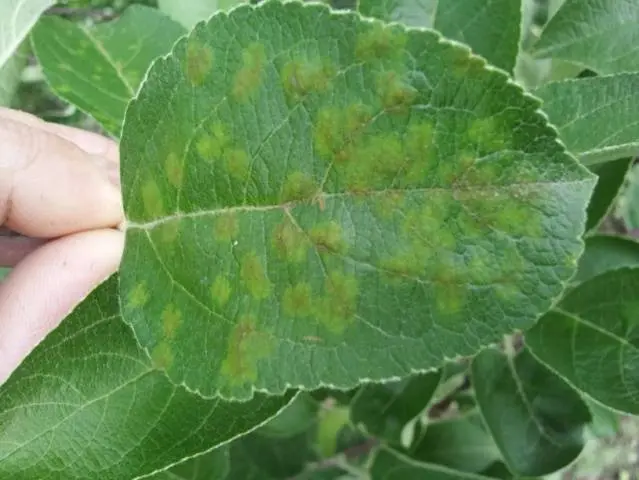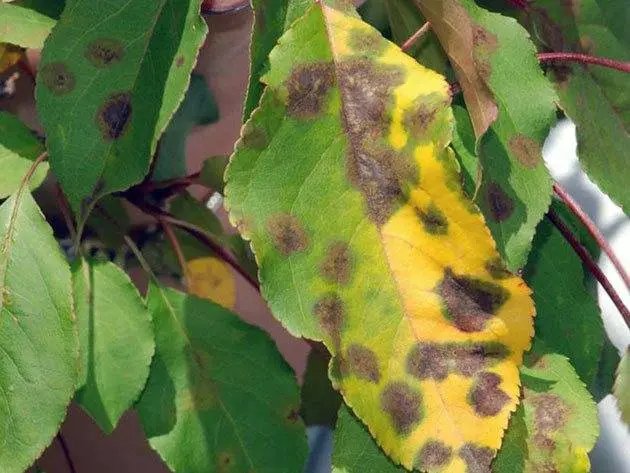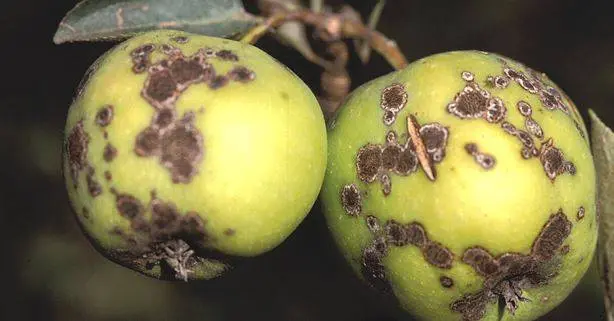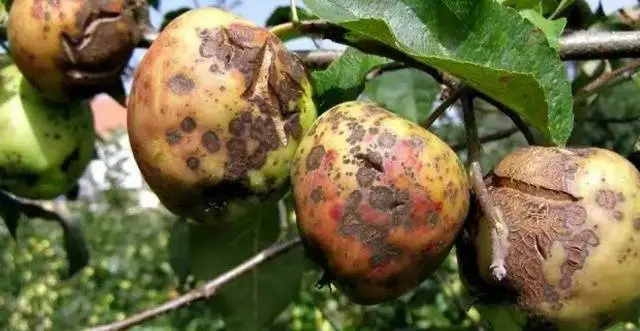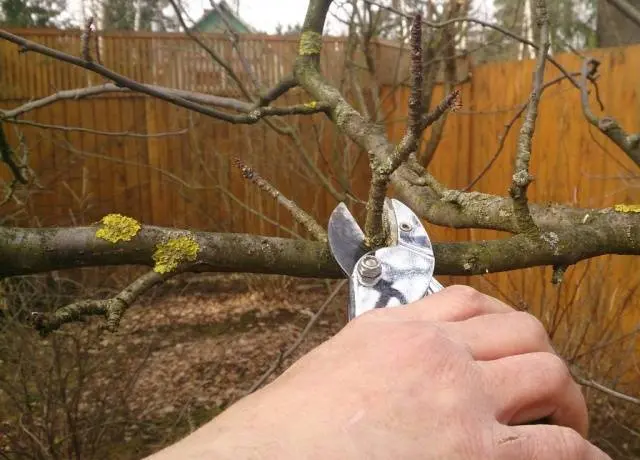Contents
What does it mean to be a “good gardener”? Perhaps this means that only the best varieties of fruit and berry crops are collected on the plot? Or does the quantity and quality of the harvest speak of high professionalism? In fact, these two words contain more voluminous concepts. First of all, every gardener knows that the yield directly depends on the observance of the rules of care and the condition of the trees. Sick cultures will not please you with their fruits.
Eastern wisdom says that “you need to study your enemy well, and then you will win hundreds of battles.” The first enemies in every garden are invariably pests and diseases. One of these is scab on an apple tree. Description, photos and methods of treatment for this scourge you will learn from this article.
What is this disease and causes
According to scientific definition, scab is the most common fungal disease affecting fruit trees. The causative agent is the marsupial fungus Venturia inaequalis (Venturia unequal). Almost all gardeners are constantly fighting or using a set of preventive measures to protect their crops from the harmful effects of scab.
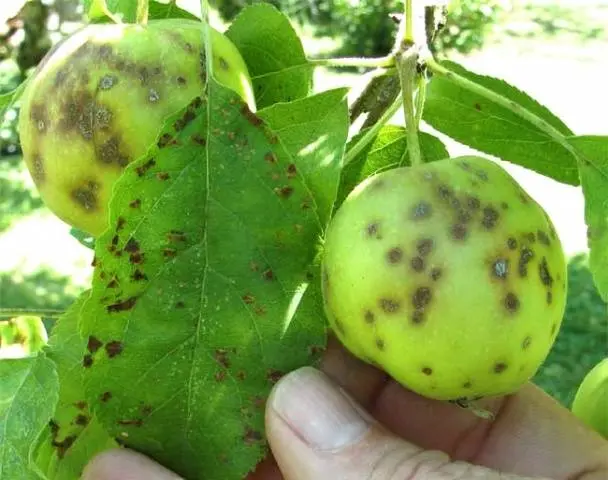
The disease is spread by spores, which are easily carried by the wind. Birds and insects also contribute to the spread of this disease. Scab spores are so resistant that they can easily tolerate low temperatures.
The smallest particles, settling on the foliage or bark of the apple tree, begin to develop rapidly. The rate of reproduction of harmful spores increases many times with high humidity. In just 7-10 days, the signs of the disease will become so obvious that it will be very difficult not to notice them.
Protecting your garden from this infection is almost impossible. And if the fight against scab on the apple tree is not started in time, the consequences can be catastrophic. The disease spreads very quickly, and in just a few years it will cause serious damage to all the trees in the garden.
A fungus that affects apple trees eventually penetrates under the bark, destroying trunks and branches. Foliage becomes mottled, blackens, and falls off prematurely. The branches crack and subsequently dry out.
The scab also leaves its mark on the fruits: apples are covered with dark spots, which crack during the ripening process. Often the fruits become small, lose their attractive, appetizing appearance. The amount of vitamins in apples decreases, their taste qualities deteriorate.
After 2-3 years, the scab-affected apple tree becomes very weak. Its resistance to low temperatures and other diseases decreases. Moreover, it becomes a source of the spread of the disease, infecting nearby trees and shrubs.
Therefore, it is very important to learn to recognize the onset of the disease in time, to carry out treatment in a timely manner and a number of preventive measures. In this case, you will secure your crops and provide your household with a harvest of tasty and fragrant apples.
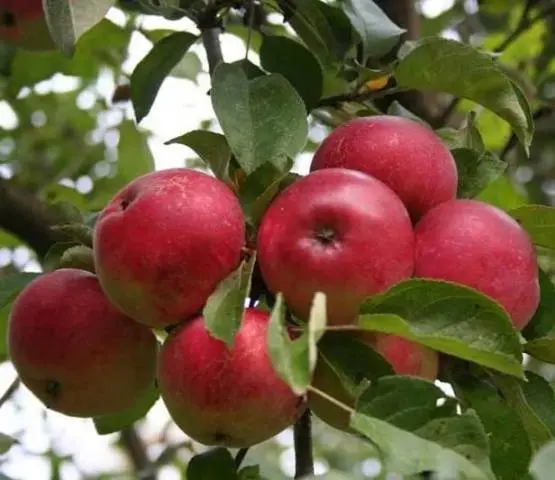
Symptoms of the disease
The main symptom of apple scab disease – dark spots – can be easily confused with other fungal infections, such as brown spot. Therefore, you need to focus on other signs that indicate the appearance of scab on an apple tree:
- first of all, scab affects young shoots;
- first, light, olive-colored, spots with a velvety coating appear on the leaves;

- gradually they darken, acquiring first a rusty, and then a black tint;
- numerous specks merge, the leaves crack and dry;

- in the future, harmful spores infect the branches, trunks and fruits of the apple tree;

- the affected leaves fall off much earlier than the due date, the branches dry up;
- there is a significant deformation of the fruit: they become ugly and small, covered with spots, the taste is noticeably reduced.

When the first signs of scab appear on apple trees, treatment should begin as soon as possible. The sooner you start treatment, the more likely it is to get rid of the disease with minimal labor and financial costs.
Methods of struggle
There are a lot of methods to deal with such a scourge as scab on an apple tree. Conventionally, they are divided into:
- traditional, that is, using safe means;
- chemical. In this case, special means based on potent chemicals are used.
Each of them has both its advantages and a number of disadvantages. Which one to use and how to treat scab on an apple tree is up to you.
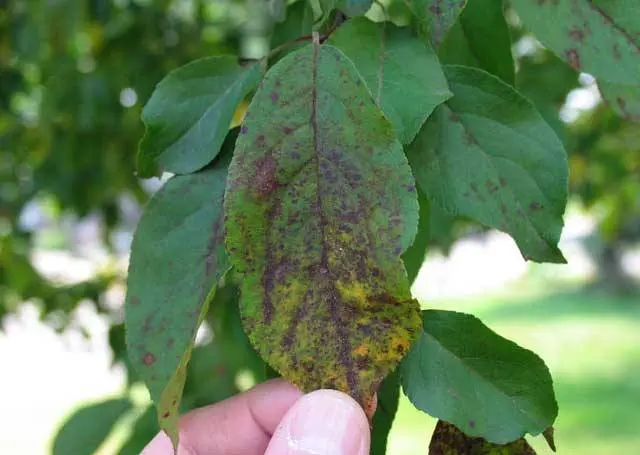
Folk methods
Despite the fact that the market provides a huge amount of fungicides that can quickly and quickly deal with such a fungal disease as scab on an apple tree, many summer residents still prefer to use folk methods to combat this disease. First of all, they focus on the safety of a particular method.
But when choosing the best remedy than to treat scab apple trees, you need to focus on the staging of the disease. If your trees have become sick relatively recently, then traditional scab treatments can be applied. At the initial stage, the probability of destroying the fungus is high. In advanced cases, such solutions will not cope with the disease, and then you will have to treat the scab on the apple tree with fungicides.
Salt, mustard, potassium permanganate
At the first sign of apple scab damage, use one of the following recipes. Also, these compounds can be used if the foliage is covered with light yellow or pale green spots. At this stage, it is difficult to establish what kind of disease we are talking about. But any disease is easier to cure in the early stages.
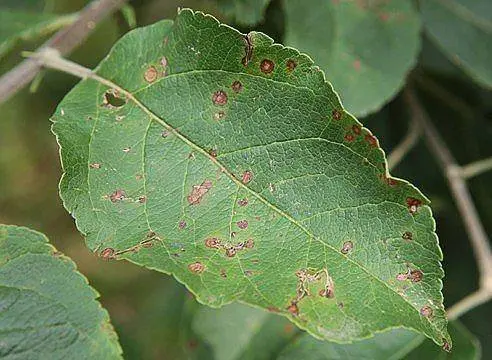
Mustard infusion
Mustard powder has a very powerful antiseptic effect, is sold in many grocery stores and costs a penny. Moreover, it is completely safe both for apple trees and for the environment, humans and pollinating insects. Processing apple trees from scab with mustard infusion does not affect the taste of the fruit at all.
This natural remedy can be used 4-5 times during the season. Scab apple trees can be treated with this solution during the following growing seasons:
- after the first leaves have blossomed;
- during the period of bud formation, but before the peduncles bloom;
- 10-15 days after flowering, when the first ovaries appear;
- 2-3 weeks before ripening and planned harvest.
In a bucket of warm water, dilute 80-100 grams of mustard powder, mix thoroughly. The resulting solution should be abundantly sprayed with apple trees.
Potassium permanganate solution
Potassium permanganate perfectly copes with many bacteria and fungi. Processing of apple trees from scab should be done with a dark pink, concentrated solution no more than 3 times per season.
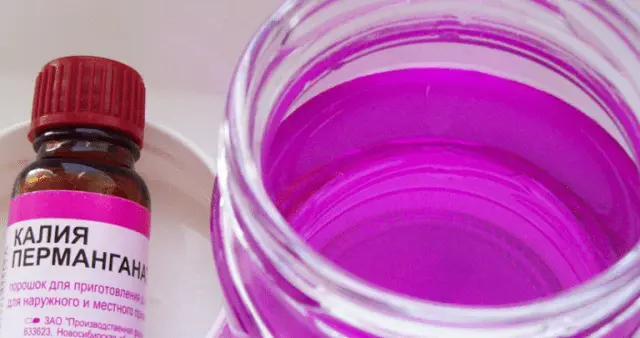
You need to spray not only the crown and branches, but abundantly irrigate the trunk and the root circle. Healthy, nearby trees can be treated with a light pink solution of potassium permanganate for prevention.
Do not be alarmed, after processing, the bark of apple trees is covered with dark brown stains. It is safe for trees and will not harm them.
Brine
Scab apple trees can be sprayed with saline in early spring. This tool, rather, has a protective function. After processing, the trees are somewhat behind in the growing season: buds bloom a little later, buds appear a few days later than usual. Scab pathogens do not survive on trunks and branches covered with saline.
Dissolve a kilogram pack of salt in 8-9 liters of warm water and mix the solution thoroughly. Water the apple trees abundantly with the resulting product. The solution should flow down the barrel.
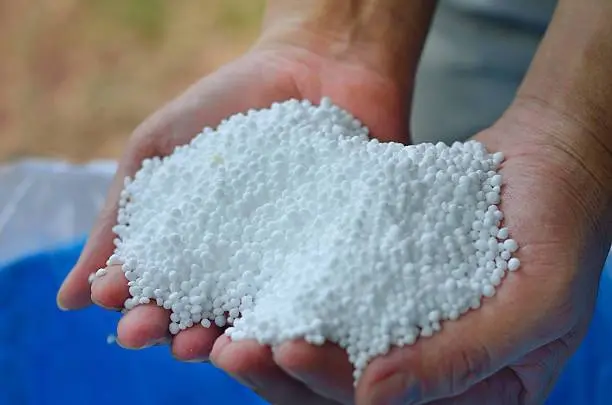
When choosing the appropriate method, do not forget that any folk remedy for scab on apple trees will only help if the disease is at an early stage. In more complex cases, it is better not to waste precious time and resort to the help of chemicals.
Chemical compounds to fight the disease
Traditional methods of scab control are effective, but every gardener knows that they work very slowly. A fungal disease, on the contrary, spreads very quickly, affecting neighboring trees and shrubs.
Therefore, if you need to get rid of scab on an apple tree as quickly as possible, you should take care of choosing fungicides. Treatment with special equipment must be carried out within strictly specified terms, adhere to the recommended dosage and do not forget about personal protective measures.
At the moment, there are many preparations for scab on the apple tree on the market, which easily destroy fungal spores and protect fruit trees from their harmful effects. But before proceeding with processing, it is important to figure out which means are most effective, when and how to properly process trees.
When choosing fungicides, please note that with the regular use of the same drug, the fungus adapts to its effects. Subsequently, seemingly powerful chemicals will be absolutely useless. Therefore, from time to time, scab preparations need to be changed.

Before processing, take care of personal protective equipment. You can spray apple trees only in dry, calm weather.
It is necessary to spray apple trees evenly, covering branches, foliage and trunks with a thin layer of the drug. It is mandatory to process all fruit crops in the garden, including berry bushes, as well as trunk circles for each tree.
The number of required treatments depends on:
- apple varieties;
- stages of the disease;
- season.
There are several preparations for scab that have proven themselves and have earned recognition among gardeners.
“Raek”
“Raek” is characterized by high activity, which is due to the rapid penetration of the solution into plant tissues.
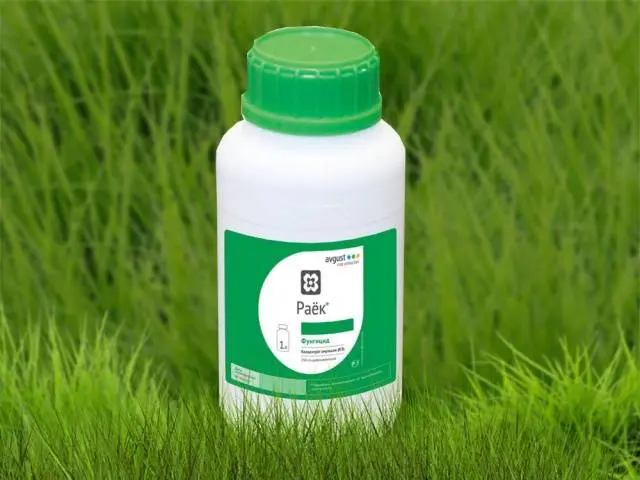
To get an excellent result, you will have to process apple trees at least 3 or 4 times:
- the first treatment is in the rosebud phase. Catch the moment when the peduncles are just forming, but before they bloom.
- the second treatment – after 1,5-2 weeks.
- subsequent preventive treatments should be carried out at intervals of 1 time in 3-4 weeks.
- The total number of treatments of apple trees with this preparation is not more than 4 times.
The drug works for 3-4 weeks, is not washed off by rain.
“Speed”
You can spray trees with this solution no more than 2-3 times. The drug is valid for 3 weeks. It is necessary to dilute the concentrate in accordance with the instructions and immediately before processing the garden.
After spraying, the emulsion solution penetrates into plant tissues within 2 hours, blocks the growth of spores, and to some extent reduces the level of sporulation.
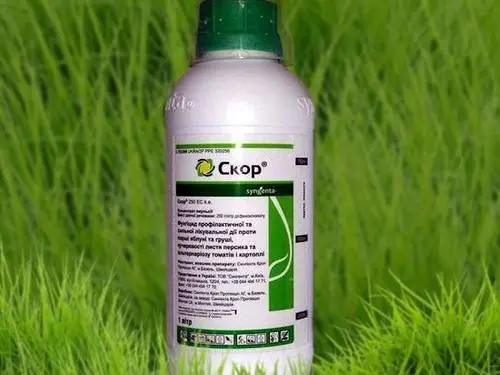
However, it is worth remembering that the “Dispute” shows an excellent result only if the scab on the apple tree is in the initial stage. If the fungus on your trees has already begun to form and scatter spores, the drug will be practically useless.
Horus
It is necessary to process apple trees from scab with Horus twice. The first time in the green cone phase, the second time – after 1-1,5 weeks.
As when working with any chemical, it is necessary to spray apple trees with Horus only in a respirator, gloves, goggles and a protective suit.
Strobi
“Strobi” is a universal drug with a wide spectrum of action. It is able to cure almost all known fungal diseases.
This drug is the only one of a large number of fungicides that can be used even during the flowering of apple trees. You can spray apple trees with an antifungal drug throughout the season. The last treatment should be carried out at least 35-40 days before the expected harvest.
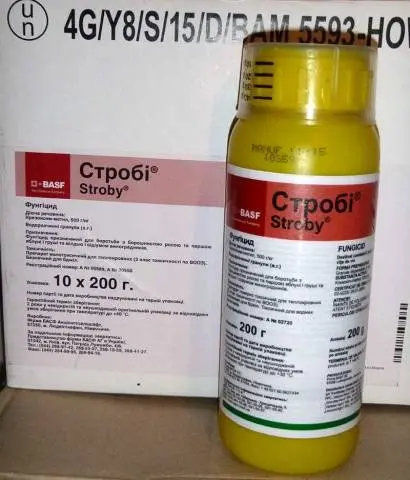
If the question arises before you: how to process apple trees from scab, give preference to “Strobe”.
Fitolavin
“Fitolavin” is an antibiotic that fights scab on apple trees and other fruit trees. In addition, it has a wide spectrum of action against many pathogens of fungal diseases. The maximum number of treatments is no more than 4 times.
The effect of the drug persists for 2-3 weeks. It has a healing effect and subsequently protects the trees from re-infection.
The fungicide provides apple trees with high-quality and fairly reliable protection for up to 20-25 days. Compared to other antifungal drugs, Fitolavin is environmentally friendly. You can spray trees with it even 7-10 days before the planned harvest.
Among gardeners, “Fitolavin” has earned only positive reviews.
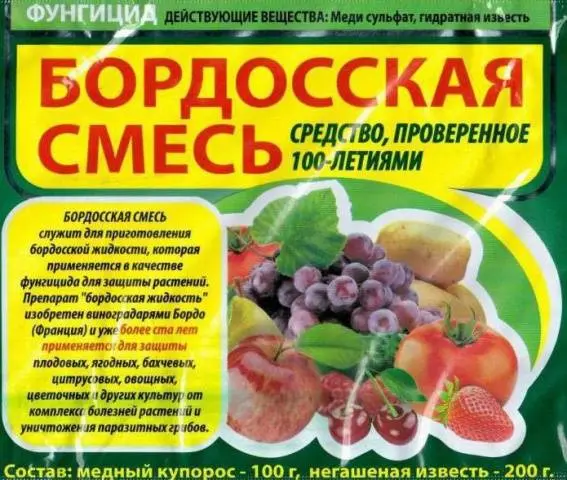
Good results are obtained by processing apple trees from scab with Bordeaux liquid. It is necessary to spray the trees with this solution in early spring very plentifully so that the drug drains from the branches and leaves in drops. After processing, the apple trees are covered with a bluish bloom. Therefore, among the people, spraying apple trees with Bordeaux liquid is called “blue irrigation”.
Time and timing of tree processing
Processing of apple trees can be carried out at almost any time of the year, except for winter. Gardeners usually start the first spraying in early spring, when the snow has just melted and warm weather has set in. Spring work can be carried out until the abundant flowering of apple trees begins. Otherwise, you may be left without a harvest.
You can resume processing the garden 2-3 weeks after the end of flowering, when the formed fruits are clearly visible on the branches. All spring work in the garden must be checked against the instructions for use of the product that you decide to use. It is important to maintain the prescribed time between treatments so as not to harm the apple trees.
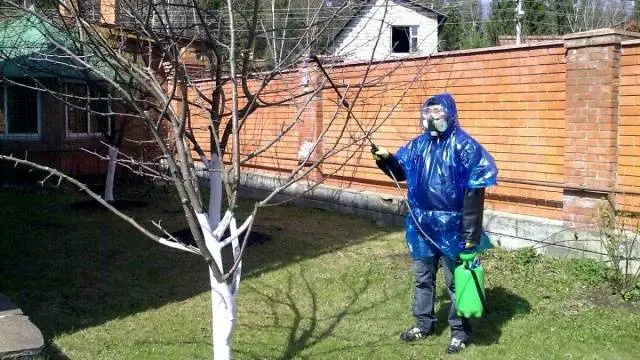
In summer, the garden can be cultivated at almost any time. When spraying early apple varieties, stop spraying at least 3-4 weeks before the fruit starts to ripen.
But in the fall, you need to start working in the garden no earlier than the last harvest. You can combine spraying apple trees with autumn work, such as pruning and processing branches, cleaning foliage and other activities.
Before you get rid of scab on apple trees, remember that in the fall you can use more powerful and concentrated solutions without fear of harming the trees.
Preventive measures
In addition to processing trees, it is necessary to regularly carry out a set of measures aimed at preventing the spread of the disease:
- Pruning apple trees in spring and autumn in order to remove damaged and diseased branches, as well as to thin out the crown.

- Regular garden cleaning. Leaves and dry branches must be collected and removed from the site. Ideally, they should be burned, but you can send the garbage to the compost pit, shifting it with a thick layer of fresh manure.
- In autumn, if lawn grass does not grow in the garden, the tree trunks need to be dug up. If there is a lawn, carefully treat the ground around the trees with fungicides.
- Damaged trunks must be cleaned, cleaned and treated with copper sulfate.
- Carefully select apple trees for the future garden – give preference to zoned varieties that are highly resistant to scab.
- Apple tree seedlings should be planted in sunny, well-ventilated areas.
- Follow the recommendations of gardeners regarding the planting of apple trees.
- Do not forget about regular feeding of apple trees – a fungal disease most often affects weakened trees.

- When the first signs of the disease appear, immediately proceed to drastic measures.
Do not miss such important events as spring and autumn whitewashing, as well as the processing of apple trees for the purpose of prevention.
The author of the video will tell you how to deal with scab on apple trees
Conclusion
It is difficult to fight such an insidious disease as scab on an apple tree. But if you follow the rules described above, you will protect your garden from this scourge, and the apple trees will thank you for your care with a rich harvest of fragrant and juicy apples.










